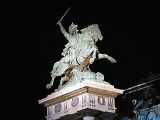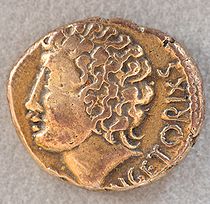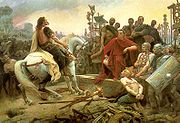
Vercingetorix
Encyclopedia

Tribal chief
A tribal chief is the leader of a tribal society or chiefdom. Tribal societies with social stratification under a single leader emerged in the Neolithic period out of earlier tribal structures with little stratification, and they remained prevalent throughout the Iron Age.In the case of ...
of the Arverni
Arverni
The Arverni were a Gallic tribe living in what is now the Auvergne region of France during the last centuries BC. One of the most powerful tribes in ancient Gaul, they opposed the Romans on several occasions...
tribe, who united the Gauls
Gauls
The Gauls were a Celtic people living in Gaul, the region roughly corresponding to what is now France, Belgium, Switzerland and Northern Italy, from the Iron Age through the Roman period. They mostly spoke the Continental Celtic language called Gaulish....
in an ultimately unsuccessful revolt against Roman
Roman Republic
The Roman Republic was the period of the ancient Roman civilization where the government operated as a republic. It began with the overthrow of the Roman monarchy, traditionally dated around 508 BC, and its replacement by a government headed by two consuls, elected annually by the citizens and...
forces during the last phase of Julius Caesar
Julius Caesar
Gaius Julius Caesar was a Roman general and statesman and a distinguished writer of Latin prose. He played a critical role in the gradual transformation of the Roman Republic into the Roman Empire....
's Gallic Wars
Gallic Wars
The Gallic Wars were a series of military campaigns waged by the Roman proconsul Julius Caesar against several Gallic tribes. They lasted from 58 BC to 51 BC. The Gallic Wars culminated in the decisive Battle of Alesia in 52 BC, in which a complete Roman victory resulted in the expansion of the...
.
Vercingetorix came to power in 52 BC, when he raised an army and was proclaimed king at Gergovia. He soon established an alliance with other tribes and took control of their combined armies, leading them in Gaul's most significant revolt against Roman power. Vercingetorix surrendered to the Romans after being defeated at the Battle of Alesia
Battle of Alesia
The Battle of Alesia or Siege of Alesia took place in September, 52 BC around the Gallic oppidum of Alesia, a major town centre and hill fort of the Mandubii tribe...
in 52 BC, after which he was imprisoned for five years. In 46 he was paraded through Rome
Rome
Rome is the capital of Italy and the country's largest and most populated city and comune, with over 2.7 million residents in . The city is located in the central-western portion of the Italian Peninsula, on the Tiber River within the Lazio region of Italy.Rome's history spans two and a half...
as part of Caesar's triumph
Roman triumph
The Roman triumph was a civil ceremony and religious rite of ancient Rome, held to publicly celebrate and sanctify the military achievement of an army commander who had won great military successes, or originally and traditionally, one who had successfully completed a foreign war. In Republican...
before being executed. Vercingetorix is primarily known through Caesar's Commentarii de Bello Gallico
Commentarii de Bello Gallico
Commentarii de Bello Gallico is Julius Caesar's firsthand account of the Gallic Wars, written as a third-person narrative. In it Caesar describes the battles and intrigues that took place in the nine years he spent fighting local armies in Gaul that opposed Roman domination.The "Gaul" that Caesar...
.
Name
The etymology of the name Vercingetorix is still contested. The most generally accepted analysis interprets it as GaulishGaulish language
The Gaulish language is an extinct Celtic language that was spoken by the Gauls, a people who inhabited the region known as Gaul from the Iron Age through the Roman period...
ver- ("over, superior" – an etymological cognate of Latin super or Greek hyper), cingeto- ("warrior", related to roots meaning "tread, step, walk", so possibly "infantry"), and rix ("king") (cf. Latin rex, Sanskrit rāja-) , i.e. "great warrior king" or "king of great warriors". In his Life of Caesar, Plutarch
Plutarch
Plutarch then named, on his becoming a Roman citizen, Lucius Mestrius Plutarchus , c. 46 – 120 AD, was a Greek historian, biographer, essayist, and Middle Platonist known primarily for his Parallel Lives and Moralia...
renders the name as Vergentorix.
History
Having been appointed governorRoman governor
A Roman governor was an official either elected or appointed to be the chief administrator of Roman law throughout one or more of the many provinces constituting the Roman Empire...
of the Roman province of Gallia Narbonensis
Gallia Narbonensis
Gallia Narbonensis was a Roman province located in what is now Languedoc and Provence, in southern France. It was also known as Gallia Transalpina , which was originally a designation for that part of Gaul lying across the Alps from Italia and it contained a western region known as Septimania...
(modern Provence
Provence
Provence ; Provençal: Provença in classical norm or Prouvènço in Mistralian norm) is a region of south eastern France on the Mediterranean adjacent to Italy. It is part of the administrative région of Provence-Alpes-Côte d'Azur...
) in 58 BC, Julius Caesar
Julius Caesar
Gaius Julius Caesar was a Roman general and statesman and a distinguished writer of Latin prose. He played a critical role in the gradual transformation of the Roman Republic into the Roman Empire....
proceeded to conquer the Gallic
Gauls
The Gauls were a Celtic people living in Gaul, the region roughly corresponding to what is now France, Belgium, Switzerland and Northern Italy, from the Iron Age through the Roman period. They mostly spoke the Continental Celtic language called Gaulish....
tribes beyond over the next few years, maintaining control through a careful divide and rule
Divide and rule
In politics and sociology, divide and rule is a combination of political, military and economic strategy of gaining and maintaining power by breaking up larger concentrations of power into chunks that individually have less power than the one implementing the strategy...
strategy. He made use of the factionalism
Political faction
A political faction is a grouping of individuals, such as a political party, a trade union, or other group with a political purpose. A faction or political party may include fragmented sub-factions, “parties within a party," which may be referred to as power blocs, or voting blocs. The individuals...
among the Gallic elites, favoring certain noblemen over others with political support and Roman luxuries such as wine
Wine
Wine is an alcoholic beverage, made of fermented fruit juice, usually from grapes. The natural chemical balance of grapes lets them ferment without the addition of sugars, acids, enzymes, or other nutrients. Grape wine is produced by fermenting crushed grapes using various types of yeast. Yeast...
. Attempts at revolt, such as that of Ambiorix
Ambiorix
Ambiorix was, together with Catuvolcus, prince of the Eburones, leader of a Belgic tribe of north-eastern Gaul , where modern Belgium is located...
in 54 BC, had secured only local support, but Vercingetorix, whose father, Celtillus, had been put to death by his own countrymen for seeking to rule all of Gaul, managed to unify the Gallic tribes against the Romans and adopted more modern styles of warfare.
The revolt that Vercingetorix came to lead began in early 52 BC while Caesar was raising troops in Cisalpine Gaul
Cisalpine Gaul
Cisalpine Gaul, in Latin: Gallia Cisalpina or Citerior, also called Gallia Togata, was a Roman province until 41 BC when it was merged into Roman Italy.It bore the name Gallia, because the great body of its inhabitants, after the expulsion of the Etruscans, consisted of Gauls or Celts...
. Believing that Caesar would be distracted by the turmoil in Rome
Ancient Rome
Ancient Rome was a thriving civilization that grew on the Italian Peninsula as early as the 8th century BC. Located along the Mediterranean Sea and centered on the city of Rome, it expanded to one of the largest empires in the ancient world....
following the death of Publius Clodius Pulcher
Publius Clodius Pulcher
Publius Clodius Pulcher was a Roman politician known for his popularist tactics...
, the Carnutes
Carnutes
The Carnutes, a powerful Celtic people in the heart of independent Gaul, dwelled in a particularly extensive territory between the Sequana and the Liger rivers. Their lands later corresponded to the dioceses of Chartres, Orléans and Blois, that is, the greater part of the modern departments of...
, under Cotuatus and Conetodunus, made the first move, slaughtering the Romans who had settled in their territory.
Vercingetorix, a young nobleman of the Arvernian city of Gergovia, roused his dependents to join the revolt, but he and his followers were expelled by the nobles of the city, including Vercingetorix's uncle Gobanitio, because they thought opposing Caesar was too great a risk. Undeterred, Vercingetorix raised an army of the poor, took Gergovia and was hailed as king. He made alliances with other tribes, and having been unanimously given supreme command of their armies, imposed his authority through harsh discipline and the taking of hostages. He adopted the policy of retreating to natural fortification
Fortification
Fortifications are military constructions and buildings designed for defence in warfare and military bases. Humans have constructed defensive works for many thousands of years, in a variety of increasingly complex designs...
s, and undertook an early example of a scorched earth
Scorched earth
A scorched earth policy is a military strategy or operational method which involves destroying anything that might be useful to the enemy while advancing through or withdrawing from an area...
strategy by burning towns to prevent the Roman legion
Roman legion
A Roman legion normally indicates the basic ancient Roman army unit recruited specifically from Roman citizens. The organization of legions varied greatly over time but they were typically composed of perhaps 5,000 soldiers, divided into maniples and later into "cohorts"...
s from living off the land.
Vercingetorix and his army won some initial minor engagements with the Roman units led by Caesar and his chief lieutenant Titus Labienus
Titus Labienus
Titus Atius Labienus was a professional Roman soldier in the late Roman Republic. He served as Tribune of the Plebs in 63 BC, and is remembered as one of Julius Caesar's lieutenants, mentioned frequently in the accounts of his military campaigns...
. However, the Romans captured the capital of the Bituriges
Bituriges
The Bituriges was a tribe with its capital at Bourges .Early in the 1st century BCE, they had been one of the main tribes, especially in terms of Druids and their political influence. But they soon declined in power as the Druids were an important target for Julius Caesar in his conquest of Gaul...
, Avaricum (Bourges
Bourges
Bourges is a city in central France on the Yèvre river. It is the capital of the department of Cher and also was the capital of the former province of Berry.-History:...
), killing the entire population of 120,000. The next major battle was at Gergovia
Battle of Gergovia
The Battle of Gergovia took place in 52 BC in Gaul at Gergovia, the chief town of the Arverni. The battle was fought between a Roman Republic army, led by proconsul Julius Caesar, and Gallic forces led by Vercingetorix...
, where Vercingetorix defeated Caesar, inflicting heavy losses. However, the victory cost Vercingetorix many men, including many noblemen. Because of these losses he retreated and moved to another stronghold, Alesia
Alesia (city)
thumb|200px|Vercingetorix Memorial in Alesia thumb|200px|right|The [[fortification]]s built by Caesar in AlesiaInset: cross shows location of Alesia in Gaul...
.

Battle of Alesia
The Battle of Alesia or Siege of Alesia took place in September, 52 BC around the Gallic oppidum of Alesia, a major town centre and hill fort of the Mandubii tribe...
(September, 52 BC), Caesar built a fortification
Fortification
Fortifications are military constructions and buildings designed for defence in warfare and military bases. Humans have constructed defensive works for many thousands of years, in a variety of increasingly complex designs...
around the city to besiege it. However, Caesar's army was surrounded by the rest of Gaul, and Vercingetorix had summoned his Gallic allies to attack the besieging Romans, so Caesar built another outer fortification against the expected relief armies (resulting in a doughnut-shaped fortification). The relief came in insufficient numbers: estimates range from 80,000 to 250,000 soldiers. Vercingetorix, the tactic
Military tactics
Military tactics, the science and art of organizing an army or an air force, are the techniques for using weapons or military units in combination for engaging and defeating an enemy in battle. Changes in philosophy and technology over time have been reflected in changes to military tactics. In...
al leader, was cut off from them on the inside, and without his guidance the attacks were initially unsuccessful. However, the attacks did reveal a weak point in the fortifications and the combined forces on the inside and the outside almost made a breakthrough. Only when Caesar personally led the last reserves into battle did he finally manage to prevail. This was a decisive battle in the creation of the Roman Empire
Roman Empire
The Roman Empire was the post-Republican period of the ancient Roman civilization, characterised by an autocratic form of government and large territorial holdings in Europe and around the Mediterranean....
.

Plutarch
Plutarch then named, on his becoming a Roman citizen, Lucius Mestrius Plutarchus , c. 46 – 120 AD, was a Greek historian, biographer, essayist, and Middle Platonist known primarily for his Parallel Lives and Moralia...
, Vercingetorix surrendered in dramatic fashion, riding his beautifully adorned horse out of Alesia
Alesia (city)
thumb|200px|Vercingetorix Memorial in Alesia thumb|200px|right|The [[fortification]]s built by Caesar in AlesiaInset: cross shows location of Alesia in Gaul...
and around Caesar's camp before dismounting in front of Caesar, stripping himself of his armor and sitting down at his opponent's feet, where he remained motionless until he was taken away. Caesar provides a first-hand contradiction of this account, describing Vercingetorix's surrender much more modestly. He was imprisoned in the Tullianum in Rome for five years, before being publicly displayed in Caesar's triumph
Roman triumph
The Roman triumph was a civil ceremony and religious rite of ancient Rome, held to publicly celebrate and sanctify the military achievement of an army commander who had won great military successes, or originally and traditionally, one who had successfully completed a foreign war. In Republican...
in 46 BC. He was executed after the triumph, probably by strangulation in his prison, as ancient custom would have it.
Memorials
Napoleon III erected a seven meter tall statue of Vercingétorix in 1865, created by the sculptor Aimé MilletAimé Millet
Aimé Millet was a noted French sculptor, who was born and died in Paris.Millet was the son of miniaturist Frederick Millet and uncle to Chicago architectural decorator Julian Louis Millet...
, on the supposed site of Alesia
Alesia
-Places:France*Alesia , an ancient city in Gaul**Battle of Alesia*Alésia , a station in the Paris Métro*Rue d'Alésia, Paris*Le quartier Alésia, an unofficial district of Paris that mostly overlaps Petit-MontrougeUnited States...
. The architect for the memorial was Eugène Viollet-le-Duc
Eugène Viollet-le-Duc
Eugène Emmanuel Viollet-le-Duc was a French architect and theorist, famous for his interpretive "restorations" of medieval buildings. Born in Paris, he was a major Gothic Revival architect.-Early years:...
. The impressive statue still stands. The inscription on the base, written by Viollet-le-Duc, reads (in French
French language
French is a Romance language spoken as a first language in France, the Romandy region in Switzerland, Wallonia and Brussels in Belgium, Monaco, the regions of Quebec and Acadia in Canada, and by various communities elsewhere. Second-language speakers of French are distributed throughout many parts...
):
- La Gaule unie
- Formant une seule nation
- Animée d'un même esprit,
- Peut défier l'Univers.
- Gaul united,
- Forming a single nation
- Animated by a common spirit,
- Can defy the Universe.
There is a statue of Vercingétorix by Bartholdi
Frédéric Bartholdi
Frédéric Auguste Bartholdi was a French sculptor who is best known for designing the Statue of Liberty.-Life and career:...
on the Place de Jaude in Clermont-Ferrand
Clermont-Ferrand
Clermont-Ferrand is a city and commune of France, in the Auvergne region, with a population of 140,700 . Its metropolitan area had 409,558 inhabitants at the 1999 census. It is the prefecture of the Puy-de-Dôme department...
(see first image).
Primary sources
- Julius CaesarJulius CaesarGaius Julius Caesar was a Roman general and statesman and a distinguished writer of Latin prose. He played a critical role in the gradual transformation of the Roman Republic into the Roman Empire....
, Commentarii de Bello GallicoCommentarii de Bello GallicoCommentarii de Bello Gallico is Julius Caesar's firsthand account of the Gallic Wars, written as a third-person narrative. In it Caesar describes the battles and intrigues that took place in the nine years he spent fighting local armies in Gaul that opposed Roman domination.The "Gaul" that Caesar...
Book 7 - Dio CassiusDio CassiusLucius Cassius Dio Cocceianus , known in English as Cassius Dio, Dio Cassius, or Dio was a Roman consul and a noted historian writing in Greek...
, Roman History 40:33-41, 43:19 - PlutarchPlutarchPlutarch then named, on his becoming a Roman citizen, Lucius Mestrius Plutarchus , c. 46 – 120 AD, was a Greek historian, biographer, essayist, and Middle Platonist known primarily for his Parallel Lives and Moralia...
, Life of Caesar 25-27
External links
- A reconstructed portrait of Vercingetorix, based on historical sources, in a contemporary style.
- Curchin, Leonard A. Lingua GallicaGaulish languageThe Gaulish language is an extinct Celtic language that was spoken by the Gauls, a people who inhabited the region known as Gaul from the Iron Age through the Roman period...
(The Gaulish Language). Retrieved January 23, 2010 from Uwaterloo.ca - Paul Marius Martin, Vercingétorix : le politique, le stratège. Paris : Perrin, 2000, 260 p. ISBN 2262016917

